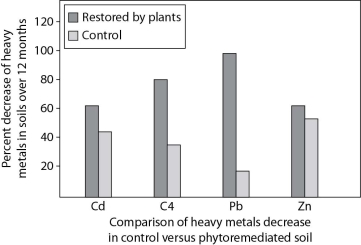Plants are sometimes used for phytoremediation in areas where the soil has been contaminated with heavy metals. Suppose the Acme Remediation Company is proposing to remediate a contaminated area that you wish to restore. Acme presents you with the following data as evidence of their company's ability to remediate soil.

-The CEO of Acme Remediation Company is always trying to improve the company's effectiveness by keeping up with current research. Which of the following research topics should have the highest priority for that research?
Definitions:
Researchers
Individuals who conduct detailed investigations in order to discover new information or reach new understandings.
Significant Results
Results obtained from statistical analysis that are unlikely to have occurred due to chance alone, indicating a meaningful difference or relationship.
Relationship Between Variables
The association or correlation existing between two or more variables in research, indicating how one variable changes in relation to another.
Predict
To declare or indicate a likely event or outcome in the future based on current evidence or patterns.
Q3: What happens to the cotyledons of pea
Q11: Which of the following is a characteristic
Q11: Which of the following has the greatest
Q30: Which of the following conditions would tend
Q34: Which of the following statements regarding the
Q39: Without crossing over,<br>A)cells could not complete meiosis.<br>B)meiosis
Q53: The expression of the tryptophan operon is
Q60: Using a six-sided die, what is the
Q67: Which part of this seed contains stored
Q82: Conjugation, transformation, and transduction are all ways